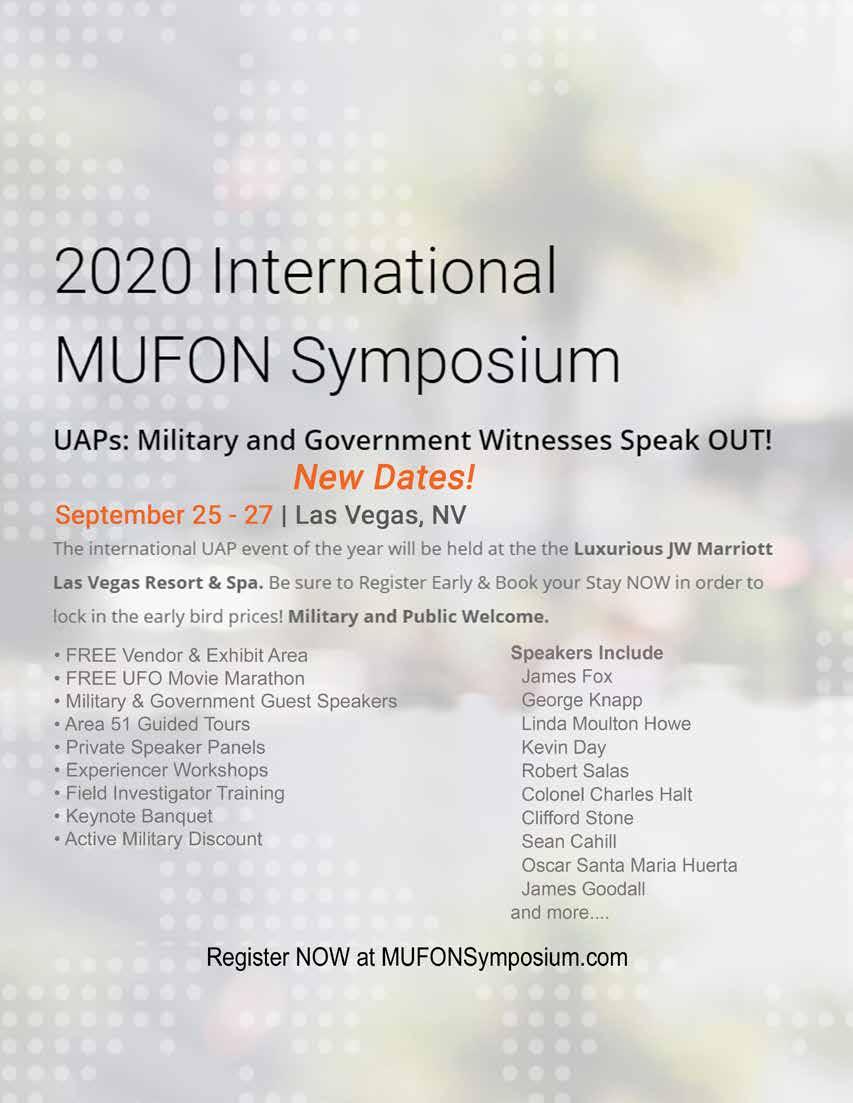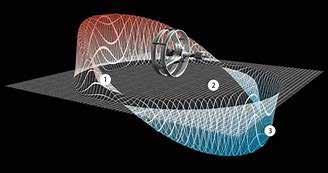
18 minute read
NEWScience
from MUFON Journal - June 2020
by MUFON
T. L. KELLER
Alcubierre Warp Drive a propulsion method modifying space-time so that faster-than-light (FTL) travel might be achieved. Proposed by Professor Miguel Alcubierre. anode a negativelycharged electrode that emits electrons.
Advertisement
Biefeld-Brown Effect the force placed on an object, positively charged on one edge, and negatively charged on the opposite edge, in the direction of the positive charge. An electrogravitic effect.
capacitor a device consisting of two or more conducting plates separated from one another by a non-conducting material and used to store an electric charge. Also called a condenser.
cathode a positively-charged electrode towards which electrons flow.
electrogravitics a technology developed by T. Townsend Brown in the 1920s demonstrated to create an anti-gravity, propulsive force. flywheel a heavy wheel for regulating the speed and uniformity of motion of the mechanical device to which it is attached.
Hg symbol for mercury on the periodic table of elements. Mercury has an atomic number of 80 (80 protons in its nucleus). Hg vapor visible particles of the liquid element mercury (as in a fine mist) suspended, in this case, in a partial vacuum. primary coil Tesla’s primary coil consists of relatively few turns of heavy copper wire or tubing. secondary coil Tesla’s secondary coil consists of many turns (hundreds or thousands) of fine copper wire in cylindrical form inside the primary coil. space-time any mathematical model that fuses the three dimensions of space and the one dimension of time into a single four-dimensional continuum.
space warp bubble a wave that would cause the fabric of space-time ahead of a spacecraft to contract and the spacetime behind it to expand. superconductivity the phenomenon, exhibited by certain metals (mercury in this instance) and alloys, of conducting electrical current without resistance when cooled to very low temperatures. Tesla coil an electrical resonant transformer circuit designed by Nikola Tesla in 1891 used to produce high-voltage, low-current, high-frequency alternating-current electricity. venturi a short tube with a constricted passage that increases the velocity of a fluid passing through it. zero point energy (ZPE) a seething mass of energy fluctuations within a vacuum at a temperature of absolute zero (-459.67° F).
Space Warp Propulsion— Part 2
Second in a series on breaking the speed of light “barrier”
Background
We know, based on Einstein’s 1915 theory of general relativity, that space-time can be curved or folded like a fabric or a material. Matter or energy can bend space-time. This article is based on previous articles published in the MUFON Journal. If you didn’t read my articles “ZPE: Breakthrough Science” in the August 2018 issue, “Space Warp Propulsion” in the October 2018 issue, “Mystical Magical Mercury—Part 1” in the December 2018 issue and part 2 in the June 2019 issue, you might wish to review them.
The Science
Repeating part of the “Space Warp Propulsion” article in the October 2018 issue, let me summarize the concept of a space warp bubble. In 1994 the Mexican physicist Professor Miguel Alcubierre,1 National University of Mexico, proposed a theory of physics for a method for changing space-time by creating a wave that would cause the fabric of space-time ahead of a spacecraft to contract and the space-time behind it to expand. The spacecraft would then ride this wave inside a region of flat space, known as a warp bubble. The spacecraft would not move within this bubble, but instead be carried along as the region itself moves due the effect created by a spacecraft’s “engine” or “drive.” One might think of the space warp bubble as a surfboarder riding a (very exotic) ocean wave.
Space warp bubble2

In the illustration on page 17, we see a ring-shaped spacecraft moving forward (toward the right) inside the space warp bubble. Positive values (red) of the bubble [1] represent the expanded part of space-time and the negative values [3] (blue) represent that portion of space-time that is contracted. Analogously, the red region might be considered as a warp “hill” and the blue region a warp “well.” The spacecraft would then ride the “wave” toward its destination. Flat space-time [2] is shown as the flat, gray area. Inside the bubble, the spacecraft and its passengers experience an undisturbed, zero gravity environment and are not affected by a time dilation. As the spacecraft moves along, the contraction balances with the expansion of space-time. Therefore, the rules of space-time and general relativity are not violated as would normally be understood. In physics, this is what is known as the Alcubierre Warp Drive. “Drive” is simply a word that represents a means of propulsion, but one that does not use chemical propellants. On paper, it is a solution of the Einstein equations, specifically how space, time and energy interact. In this particular model of space-time, there are features that are reminiscent of the fictional “warp drive” or “hyperspace” from Star Trek, Star Wars and other popular sci-fi films and TV series. This would allow our spaceship to be transported in excess of the speed of light.
The Alien Reproduction Vehicle
In the June 2019 “Mystical Magical Mercury—Part 2” article, a short history of what has been called the “alien reproduction vehicle” was presented. Now, we are prepared to describe in an exclusive report how the alien reproduction vehicle (ARV) or “flux liner” operates based on the latest revelations by Mark McCandlish. McCandlish, who is a professional, aerospace illustrator, has spent the last three decades developing a detailed engineering drawing of the ARV, which his friend Brad Sorensen saw demonstrated in 1988. Based upon descriptions provided by Sorensen, an unnamed artist produced the ARV cutaway drawing shown below. It was first published in 1991 in Bill Cooper’s book, Behold A Pale Horse, and colorized at a later date.
Who Built The ARV?
In his 1991 book, Behold A Pale Horse, 4 William “Bill” Cooper reported that the ARV was “built by Northrop, McDonald [sic] Douglas, and General Electric.” Brad Sorensen originally reported that he saw three ARVs inside the “Big Hangar” at Norton Air Force Base in 1988. But according to Timothy Good:
“In later tellings, he [Sorensen] added a twist: that in fact the demonstration did not occur at Norton [Air
Force Base]. Rather, a group was escorted aboard an
Air Force passenger jet and flown fifty miles northwest to Palmdale. They arrived at the Lockheed Martin
Skunkworks [sic] facility at the west end of the com-
plex, and it was here that the entire exhibit was held. It appears that Sorensen was originally trying to withhold certain pieces of the story.”5 As a result, the logical conclusion is that all three of the flying discs were designed and developed by Lockheed Martin Advanced Development, known as the Skunk Works, in Palmdale, California. According to Sorensen, they were all of the same design, only in different diameters—24, 60 and 120–130 feet. The illustration above is clearly the ARV with a 24-foot diameter at the base. It seems likely that a company such as General Electric was one of the subcontractors.
Crew Compartment
The crew compartment is constructed not as a hemisphere, as one might have expected, but as a sphere. Presumably, the spherical design is used as the most basic and efficient form of pressure containment. The ARV has a crew of three (not four as originally reported). The three ejection seats are mounted, facing outward, against a central column that runs from the top of the compartment into the propulsion and equipment space below. Access and egress are made though a submarine-style hatch as shown. There are no windows. Views to the exterior are made through a set of seven television cameras mounted strategically on the exterior of the crew compartment and operate in a manner similar to the gun-slaving system on an Apache helicopter. How does that work? According to McCandlish:
“If [the pilot] wants to look behind him, he can pick a view in that direction, and the cameras slew in pairs. [The pilot] has a little screen in front of his helmet, and it gives him an alternate view. He [also] has a little set of glasses that he wears — in fact, you can actually buy a 3-D viewing system for your video camera now that does the same thing — so when he looks around, he has a perfect 3-D view of the outside, but no windows.
Well, it’s probably because the voltages that we’re talking about [being] used in this system were probably something between, say, half a million and a million volts of electricity.”6 Below the circular floor of the crew compartment is a ninefoot diameter flywheel. Normally, a flywheel would regulate the speed and uniformity of motion of a vehicle, but here it has two purposes: it functions as a mass stabilizer and as a unipolar, electrical generator.7
Directional Control
As was discussed at some length in my article “Electrogravitic Propulsion,” at the base of the ARV is an approximately 24-foot diameter, round capacitor. The capacitor is constructed in 48 separate, individual and equal sections, shaped like pizza sections. Each section has eight plates. Using the Biefeld-Brown Effect, the plates are stacked
sequentially from the bottom: negative, positive, negative, positive, negative, positive, negative, positive, with a positive plate on the top. When this set of plates is activated with electrical power, it moves in the direction of the positive plates. For example, if you wish to move vertically, you would send power to all capacitor sections. Since the ARV moves in the direction of the positive plates and all plates are then powered, the ARV would move vertically upward. If you wish to move in the northwest direction, you would only power the plates on the northwest side of the ARV.
The Control System
Now, whether you are in a planetary atmosphere or in space you have to have very fine control over the direction in which you are traveling (particularly if you are doing fasterthan-light travel!). So, you need to be able to finely allocate electrical power to only those sections of the capacitor that will send you in the desired direction. Here’s McCandlish’s description:
“Now, when Brad described the control system, he said that on one side [of the pilot’s seat] there was this big high-voltage potentiometer — it’s like a rheostat, a big controller. It allows you to put progressively more electricity through the system as you push the lever. On the other side of the control system, there was a sort of a metallic bar that came up like a stork’s neck, and right at the very tip of it was a sort of metallic-looking ball, almost like it was magnetically attached to it. . . It was literally on a sea of energy.8
The Tesla Coil
Where does the electrical energy come from? The diagram on page 18 shows what is like a giant Tesla coil. The Tesla primary coil (see diagram) is located at the waist or beltline of the ARV and encircles the ARV. It consists of square copper tubing, sixteen layers deep, with a triangular cross-section. “Start-up” electricity is from two 24-volt, marine-type batteries (not shown). According to McCandlish:
“[Then] you step up that electricity through the secondary coil , which is on the [central] column in the middle, and you get this extremely high voltage. You can selectively put the voltage on any of these 48 capacitor sections.9
The Tesla secondary coil (see diagram) is in the center of the primary coil and surrounds the central column.
The Central Column
The central column contains two cylinders—a main cylinder and an inner cylinder. Both of these cylinders contain mercury vapor in a partial vacuum. Inside the main cylinder, there is a second, inner cylinder with an unusually-contoured shape (described below). During operation, the entire column of mercury vapor is subjected to a very high voltage from the secondary Tesla coil. There is an anode at the base of the column (see diagram) where the high voltage, electron stream from the coil is discharged. The inner cylinder rotates so as to create a violent vortex of mercury vapor within that cylinder. The upper end of the interior cylinder acts as a venturi for this purpose and also as a cathode. The mercury vapor goes down the inner cylinder and up through the gap between the inner cylinder and the inner wall of the main cylinder. There are no voids within the column.10
What causes the cylinders to rotate? Mercury placed in a magnetic field and then subjected to an electrical current will naturally rotate.11, 12 This causes the inner cylinder to rotate on a set of bearings. The inner cylinder is connected to a pair of planetary gear drives that drive the outer cylinder in the opposite direction to achieve counter-rotation. The rotating inner cylinder also drives the flywheel/unipolar generator. For those who missed my article “Mystical, Magical Mercury—Part 1”, the process described here was first tested in “The Bell” experiment by Nazi Germany during WWII. Not to put too fine a point on this: “The Bell” discharged high-voltage electricity into mercury vapor under a high-velocity vortex.13
The Distortion of Space-Time
From my article on zero point energy (ZPE), we learned that it’s a seething mass of energy constantly fluctuating throughout the Universe. As the ARV passes through the ZPE, the ZPE is drawn into the system interacting with the mercury vapor vortex under high voltage. As the ZPE is absorbed, the ARV, under these conditions, prevents the ZPE from interacting with the atomic structure of the vehicle. At the atomic level, this lessened ZPE absorption reduces the mass of the of the entire ARV. This sequence causes the ARV to become mass-reduced (i.e., with lesser mass). As the ARV increases in velocity, it encounters increasing amounts of ZPE, thereby further reducing the ARV’s mass. Concurrently, the ZPE provides additional power to the capacitor section. This dual combination of effects, this very elaborate, electrochemical “exotic dance,” distorts space-time and creates a space-time “bubble” around the ARV. As McCandlish says, “In effect, the faster you go, the easier it becomes to go up to and exceed the speed of light.”14 So why use mercury vapor? Mercury is a superconductor. So, mercury vapor conducts electricity without any resistance. According to McCandlish, “it produces all kinds of ionic effects. These little molecules of mercury become charged in unusual ways, and if you fire a tremendous amount of electricity through mercury vapor that’s in a partial vacuum, there is something unusual that happens in that process.”15 The end result is that space-time in the
Performance
The following is extracted from Timothy Good’s Earth: An Alien Enterprise:
“Nearby, a [three-star] general was addressing a group of people, referring to the craft and citing various attributes, including an extravagant claim that they could perform at “light speed or better,” [Richard]
Dolan learned from McCandlish. “It had extraordinary acceleration and maneuverability, able to move from a ground-level hovering position to 80,000 feet within 2.5 seconds. . . . Sorensen noted that the [ARV] looked
‘ancient’ and as though it had been used extensively.”16
Cross Talk With Mark McCandlish
The following are direct quotations from McCandlish based on more recent whistleblower testimony:17
TLK: What material composes the main and inner cylinders?
MM: “Two counter-rotating, fused Quartz cylinders.
The upper end of the inner cylinder acts as a kind of venturi and cathode discharge port for the high voltage from the Tesla Coil section. The internal cylinder contours resemble an ancient Greek shipping bottle called an Amphora. The shape creates a self-stabilizing
“smoke ring” formation of high-energy Mercury ions that in turn create their own electromagnetic field. The timing of this event is critical so that the field lines of the Tesla Coils, (primary and secondaries) coincide with the formation of this traveling ring of Mercury ions. This creates the non-destructive electromagnetic pinching effect. At the same time, the capacitor array and the coils are in a kind of reflective resonance like a [oscillating] circuit, which has certain properties that might appear as “free energy” but are in fact benefiting from what amounts to a “virtual plasma” in the core. All the benefits of a true plasma but without the destructive heat. Probably the means by which Zero Point
Energy is drawn into the system.”
TLK: How far from the ARV’s exterior does the [space-time] “bubble” extend?
MM: “The radius increases in proportion to the power level that the propulsion system is operating at. At high power, mainly after dark, within the atmosphere, it appears as a brilliant bluish-white sphere. At low or the lowest power level, say in a hover above the ground, it is nearly conformal to the shape of the craft itself. The color of the field changes with power output as well, starting out as a magenta, then red, orange, yellow-orange, yellow, yellow-white, white and then a bluish white or white with a bluish corona. Ionization trains are usually just white and grow in length with the velocity of the craft.” TLK: How is space-time controlled once the “bubble” is created?
MM: “The [allocation] of voltage to the capacitor [sections] within the array help to change the topology of the field and essentially steer the craft.”
Additional ARV Features and Video
Years after the cutaway drawing was first published in 1991, new features have come to light. More recently, the updated drawings have shown a series of air tanks radiating outwardly and horizontally from the center column of the ARV. Additionally, there is a folding, remote manipulator arm (similar to the space shuttle RMA, but much smaller) and an exterior panel that, when opened, would allow the arm to extend and grasp objects in space (such as a component of a satellite, for example). And, there are apparently rails at the back of each crew seat for ejection in the event of an emergency. McCandlish has noted that the entire ARV when, viewed from the exterior, is uniformly gray in color.
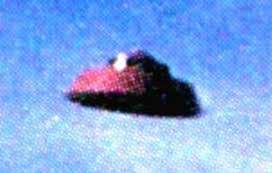
Alleged USAF photo of ARV near Provo, Utah (1966)18
There’s a full-length video on YouTube.com that has an extended narrative by McCandlish, Michel Schratt and others. The video shows examples of the evolution of the ARV drawing over the decades. The video is somewhat dated, so many of the details in this article are not presented in the video. See Note 3 below.
Commentary
This startling description is the result of three decades of deductive, scientific and engineering analysis on the part of Mark McCandlish. If the reader were to review my article “Space Warp Propulsion” in the October 2018 MUFON Journal, one consistent theme is apparent: faster-than-light
MUFON MINUTES
MARKETA KLIMOVA
Due to the COVID-19 situation, all in-person meetings are suspended until further notice.
MUFON welcomes new Field Investigators:
Richard Harris, OH; Glen Selwood, ME; Brian Millard, CA; Sean Lovett, VA; Richard Uhlhorn, CO; Dwayne Young, AZ; Michael Martella, WI; Angel Villegas, FL; Gary Teeler, TX; Rob Dingman, NY; Richard Keener, NC; David Wade, NM; Troy Thomson, Australia; Anthony Greening, Canada (AB); Robert Brede, United Kingdom.
Congratulations to the following MUFON
appointees: James Wolford, Chief Investigator, IN; Steven Bates, Assistant State Director, TX; Maria Tellier, Assistant State Director, NM; James Gilchrist, State Section Director, TX; John Pick, State Section Director, TX; Fred Campillo, State Section Director and STAR Team, TX; John Fegel, State Section Director, NM; Rick Peters, State Section Director, FL; Sonia Rivera, STAR Team, AZ.
DELAWARE MUFON typically meets on the 3rd Saturday monthly, 2–4 p.m., Woodlawn Library, 2020 West Ninth Street, Wilmington, DE. Visit our Facebook page (MUFON Delaware) and/or our website mufonde.com for information on our upcoming scheduled meetings. Our meetings consist of presentations, open discussions and movies related to the subject of UFOs. Currently, we are looking at the ZOOM option for our meetings. www.mufonde.com
PHOENIX MUFON welcomes Kevin Day on Saturday, June 27. Kevin will recount his 2004 experience as radar operator aboard the USS Princeton during the Tic-Tac UFO event. 12–3 p.m. at the Arizona Historical Society Museum in Tempe. www.phoenixmufon.com
MUFON MINUTES ITEMS: Send state notices of meetings and events to Marketa Klimova at HQ@mufon.com for inclusion before the 10th of the month prior to the month of the event. l
See Something? Say Something at MUFON.com
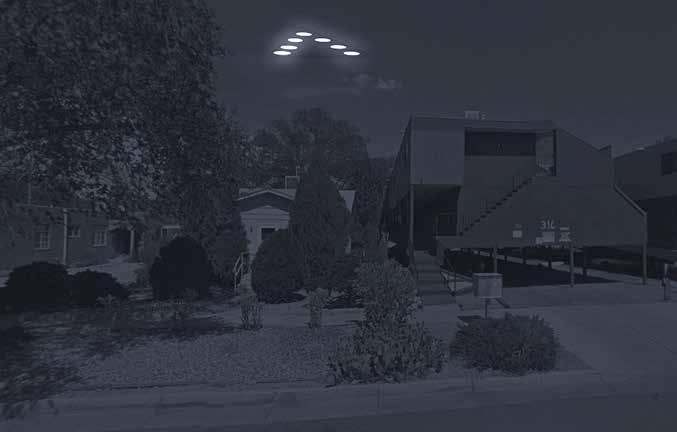
travel has been achieved, under very specific conditions, through the discharge of massive amounts of high-voltage, electrical energy. Both are examples of the Alcubierre Warp Drive theory. As this version of FTL travel was perfected no later than the (early?) 1980s, and some suggest even earlier (1966?), then what has taken place during the last three decades or so? We’ll leave that, temporarily, for the reader to ponder. Stayed tuned . . .
Notes
1. Keller, T.L., The Total Novice’s Guide To UFOs, 2FSPress, 2010, page 431, and digital edition, 2016.
2. Artist conception courtesy of Peter Turchin, www.socialevolutionforum.com
3. Cooper, Milton William, Behold A Pale Horse, Light Technology
Publishing, 1991, page 406. Used with permission from Light
Technology Publishing. Artist unknown. For copyright reasons, the most recent ARV image by McCandlish could not be displayed in this article. The most recent, updated color images and video narra tives by McCandlish and others may be viewed at: https://www. youtube.com/watch?v=aXluuOaZ14g
4. Ibid.
5. Good, Timothy, Earth: An Alien Enterprise, Pegasus Books, 2013, page 264. Timothy Good is the British author of the classic book
Above Top Secret: The Worldwide UFO Coverup (1988). 6. Keller, op. cit., page 175.
7. E-mail from Mark McCandlish to T. L. Keller, March 9, 2019.
8. Keller, op. cit., page 176.
9. Keller, op. cit., page 175.
10. E-mail from Mark McCandlish to T. L. Keller, March 9, 2019.
11. Ibid.
12. This property was discovered in 1822 by British scientist Michael
Faraday and is known as “Faraday’s electric motor.” https://www.rigb.org/our-history/iconic-objects/iconic-objects-list/ faradays-motor
13. Keller, T. L., “Mystical, Magical Mercury—Part 1,” MUFON Journal, December 2018, pages 16–19.
14. Keller, The Total Novice’s Guide To UFOs, op. cit., page 177.
15. Ibid, page 178.
16. Good, page 265.
17. E-mail from Mark McCandlish to T. L. Keller, March 9, 2019.
18. Courtesy of Michael Schratt.
To the readers: If you have a specific topic that you would like presented, please contact the editor. l
The Right Stuff quotation of the day....
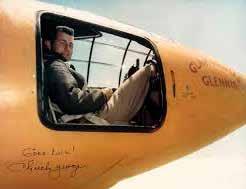
“None. I don’t drink before I fly.”
Brigadier General Chuck Yeager, USAF (Ret.) [when asked how many UFOs he’d seen.] First to break the speed of sound “barrier” in level flight (1947).
